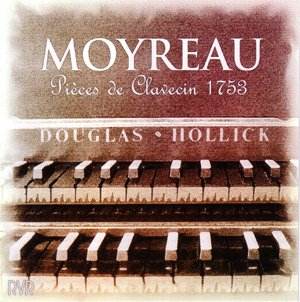AVAILABILITY
www.rvrcd.co.uk
Christophe Moyreau, born in Orléans in the "provinces",
lived and worked in his birthplace city all his life. This isolation
from the centre of culture in France was likely what made Moyreau a
little-known composer, both during his lifetime and after. Yet this
distance may also have contributed to the style of his music, which
is very different from that of other harpsichordists of the time or
earlier. Unlike Couperin, Moyreau does not overwhelm the listener with
ornamentation, though his music is not devoid of it. He also eschewed
the flashy, virtuoso style that was so prevalent in the 18th century
in France. His music is subtle and moving; he seeks out emotion rather
than showiness.
Moyreau wrote six books of solo keyboard music, all
of which were published in 1753. His works are laid out in huge suites,
ranging from 18 to 26 movements, far more than other composers at the
time or since. This recording features a selection of his works, with
pieces chosen from each of the six books. However, it is unfortunate
that this is just a selection, as opposed to one of these long suites.
It would be very interesting to hear how they were constructed.
Douglas Hollick plays this music on a harpsichord he
built, which has the perfect sound for this type of music. It is both
delicate and ample, and the upper range of the instrument is especially
attractive, and not at all harsh. Two of the pieces are played on the
organ, and show the diversity of Moyreau's compositions.
Some of the pieces are subtle explorations of simple
melodies, such as the moving La Guepine, a rondeau played "gracieusement",
which uses subtle ornamentation to underscore a melancholic melody.
Moyreau's works often remain in the high end of the instrument, and
this piece is no exception. It draws some of its unique sound from the
lack of any low bass notes.
The lush texture of the allemande from livre III is
quite surprising. Moyreau here shifts between notes that alternate left
and right hands and Scarlatti-esque chords. Again played almost entirely
at the upper end of the keyboard, the sound is light and airy.
The somewhat canonical L'Agissante, in livre
II, recalls Scarlatti in its lively staccato chords and quirky rhythm,
and the Sinfonia II in B flat, from livre VI, also uses a lot of rhythmic
tricks to create a lively, energetic tone.
This is a delightful recording, well played by Douglas
Hollick on an attractive harpsichord. The only negative aspect is that,
as much of this music is in the treble range of the instrument, some
listeners may get a bit tired of the sound. It's a shame that this harpsichord
isn't heard in its full range, but the music was written that way.
Kirk McElhearn


